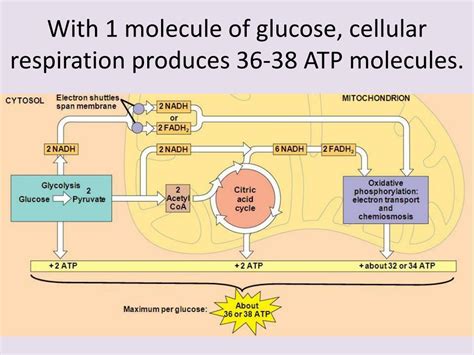Cellular respiration is a fundamental biochemical process that converts glucose into energy in the form of adenosine triphosphate (ATP). This process provides the energy required for all cellular activities, including muscle contraction, protein synthesis, and nerve impulse transmission.

Cellular respiration occurs in three main stages: glycolysis, the Krebs cycle (citric acid cycle), and oxidative phosphorylation.
Glycolysis
Glycolysis is the first stage of cellular respiration and occurs in the cytoplasm of the cell. In glycolysis, one molecule of glucose is broken down into two molecules of pyruvate, yielding a net gain of 2 ATP molecules.
The Krebs Cycle
The Krebs cycle, also known as the citric acid cycle, occurs in the mitochondria of the cell. In the Krebs cycle, each molecule of pyruvate from glycolysis is combined with coenzyme A (CoA) to form acetyl-CoA. Acetyl-CoA then enters the Krebs cycle, where it is oxidized to produce carbon dioxide, ATP, and reduced electron carriers (NADH and FADH2).
Oxidative Phosphorylation
Oxidative phosphorylation is the final stage of cellular respiration and occurs in the inner mitochondrial membrane. In oxidative phosphorylation, the electron carriers (NADH and FADH2) produced in glycolysis and the Krebs cycle are used to generate ATP through a series of electron transport reactions. This process yields the majority of ATP produced during cellular respiration.
Under ideal conditions, the complete oxidation of one molecule of glucose through cellular respiration yields approximately 38 ATP molecules. This yield is distributed as follows:
| Stage of Cellular Respiration | Number of ATP Molecules |
|---|---|
| Glycolysis | 2 |
| Krebs Cycle | 2 |
| Oxidative Phosphorylation | 34 |
| Total | 38 |
Cellular respiration is essential for life. Without cellular respiration, cells would not have the energy they need to carry out their essential functions. This would eventually lead to cell death and the collapse of the organism.
The understanding of cellular respiration has led to numerous applications, including:
- Bioenergetics: Cellular respiration is the foundation of bioenergetics, the study of energy flow in biological systems.
- Medicine: Defects in cellular respiration can lead to a variety of diseases, including mitochondrial disorders and cancer.
- Biotechnology: The principles of cellular respiration are used in the development of new drugs and therapies.
Research in cellular respiration is ongoing, with a focus on:
- Improving the efficiency of cellular respiration: This could potentially lead to new treatments for diseases that involve impaired energy metabolism.
- Developing new applications: The principles of cellular respiration continue to inspire the development of new technologies in fields such as nanotechnology and renewable energy.
Cellular respiration is a vital process that converts glucose into energy in the form of ATP. This process is essential for life and has broad applications in medicine, biotechnology, and other fields. Ongoing research in cellular respiration promises to lead to new discoveries and advancements in the future.
1. What is the overall equation for cellular respiration?
C6H12O6 (glucose) + 6O2 (oxygen) → 6CO2 (carbon dioxide) + 6H2O (water) + 38ATP (ATP)
2. Where does cellular respiration occur?
Cellular respiration occurs in the cytoplasm and mitochondria of the cell.
3. What is the difference between glycolysis, the Krebs cycle, and oxidative phosphorylation?
Glycolysis occurs in the cytoplasm and breaks down glucose into pyruvate. The Krebs cycle occurs in the mitochondria and generates carbon dioxide, ATP, and reduced electron carriers. Oxidative phosphorylation occurs in the inner mitochondrial membrane and generates ATP through electron transport reactions.
4. How many ATP molecules are produced per molecule of glucose?
Under ideal conditions, the complete oxidation of one molecule of glucose through cellular respiration yields approximately 38 ATP molecules.
5. What are some defects in cellular respiration that can lead to disease?
Defects in cellular respiration can lead to a variety of diseases, including mitochondrial disorders and cancer.
6. What are some applications of cellular respiration?
Applications of cellular respiration include bioenergetics, medicine, and biotechnology.
Table 1: Stages of Cellular Respiration
| Stage | Location | Key Events |
|---|---|---|
| Glycolysis | Cytoplasm | Glucose is broken down into pyruvate |
| Krebs Cycle | Mitochondria | Pyruvate is oxidized to produce carbon dioxide, ATP, and reduced electron carriers |
| Oxidative Phosphorylation | Inner mitochondrial membrane | Electron carriers are used to generate ATP |
Table 2: Yield of Cellular Respiration
| Stage of Cellular Respiration | Number of ATP Molecules |
|---|---|
| Glycolysis | 2 |
| Krebs Cycle | 2 |
| Oxidative Phosphorylation | 34 |
| Total | 38 |
Table 3: Defects in Cellular Respiration and Associated Diseases
| Defect | Associated Disease |
|---|---|
| Impaired glycolysis | Muscle disorders, red blood cell disorders |
| Impaired Krebs cycle | Mitochondrial disorders |
| Impaired oxidative phosphorylation | Cancer, neurodegenerative disorders |
Table 4: Applications of Cellular Respiration
| Application | Field | Description |
|---|---|---|
| Bioenergetics | Biology | Study of energy flow in biological systems |
| Medicine | Healthcare | Diagnosis and treatment of diseases involving cellular respiration |
| Biotechnology | Science | Development of new drugs and therapies |
